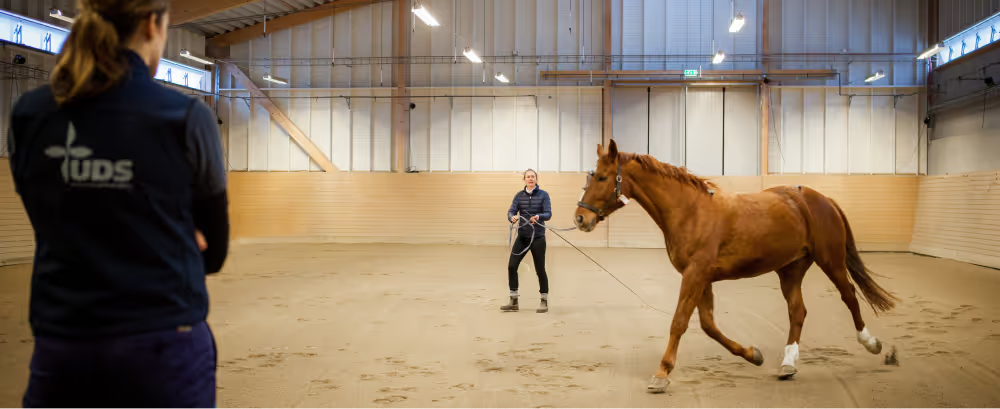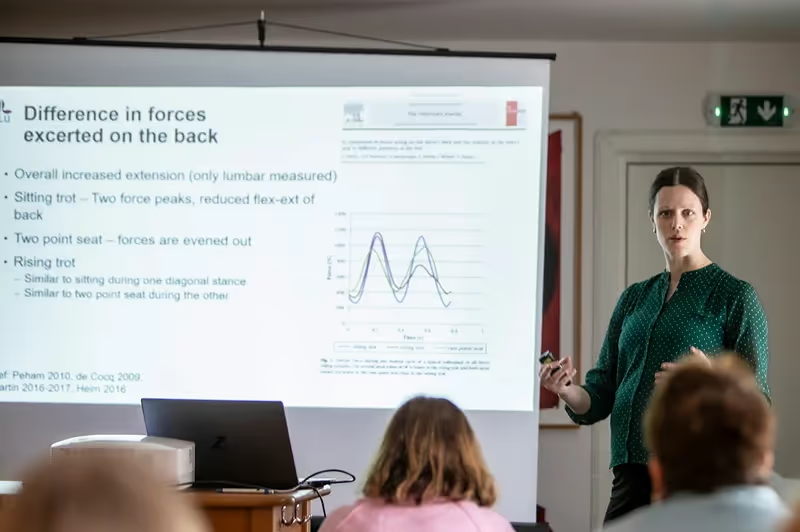
13 July 2023
I believe most equine veterinarians agree that evaluating the horse under a rider can be invaluable in identifying lameness or top-line issues. That is why it is often included in lameness workups. Studies have shown that the increased loading of the back can lead to increased lumbar back extension (1-2), potentially exacerbating back problems.
The riders influence on horse's movement in general is also important. Certain issues become more noticeable with increased impulsion and collection or during specific movements. However, the presence of a rider can also complicate the evaluation process. The rider's seating style can create systematic asymmetries in the horse's movement that resemble hindlimb lameness. It is crucial not to mistake this for true hindlimb lameness. In this blog, we’ill review existing knowledge and offer guidance on avoiding clinical pitfalls during objective assessments of a ridden horse.
Riding can be performed using various seating styles. In the sitting trot, the rider remains seated in the saddle throughout the entire stride cycle. In the two-point seat, however, the rider stands up, supporting their full weight in the stirrups. Lastly, in rising trot, the rider alternates between sitting briefly during one diagonal stance and standing up during the other. When riding in circles or making turns, the equestrian community defines the 'correct diagonal' as the rider sitting down when the outside forelimb and inside hindlimb are in stance. The correct diagonal feels more comfortable to the rider, but why is this?
Research has demonstrated that these different positions affect the forces exerted by the rider on the horse's back in varying ways. During the sitting trot, higher peak forces have been observed compared to the two-point seat, which creates a more consistent load (3). Generally, the rising trot is considered less demanding on the horse than the sitting trot. However, although the standing phase is similar to the two-point seat with lower peak forces, the seated phase is instead comparable to the sitting trot (3-4) and the increased peak force is counteracted by the horse stiffening its back under the saddle (5).
How does this translate to the vertical movement symmetries we use to measure lameness, such as with the Sleip app? While there are some studies (6-8) on this topic, it has not been fully investigated yet. However, we can draw certain conclusions that are very useful for correctly interpreting measurements taken under saddle.

Very similar to the systematic asymmetry induced by longing, which is covered in another blog, the rider in rising trot also induces systematic asymmetry patterns that we need to know about.
The rising trot primarily results in a notable asymmetry in the upward movement of the hindquarters. This effect is likely attributed to the downward momentum exerted on the horse when the rider actively rises, counteracting the push-off motion of the hindlimb intended to propel the horse's hindquarters upwards. Consequently, this asymmetry induced by the rider resembles a push-off lameness in the hindlimb during which stance the rider is sitting. Additionally, the rising trot also affects impact asymmetry, mimicking an impact lameness in the hindlimb during which stance the rider is standing up. Probably due to the rider increasing the sinking of the pelvis when sitting down during the other hindlimb stance.
When ridden on a circle, the asymmetry pattern created by the rider rising on the correct diagonal mirrors that which is induced by the circular path. Thus, these two cancel each other out, rendering the horse’s movements more symmetrical and comfortable for the rider. The opposite is true if the rider is rising on the incorrect diagonal, the asymmetries from the circle and the rising trot accumulate, explainingwhy the correct diagonal feels “better”.
The primary systematic effects observed were in the pelvic movement. However, a minor effect resembling a push-off lameness, characterized by a higher head elevation following push-off from the sitting diagonal, was discernible. Although the movement of the withers was not evaluated, it is reasonable to speculate that the effect would be more apparent compared to head movement and similar to that observed in pelvic movement.
The effect of rising trot on lameness has yet to be investigated. However, as many may know, even horses considered sound by their owners often exhibit asymmetries (9). In a previous study conducted by our research group (8), we examined the impact of rising trot on these pre-existing vertical movement asymmetries. It’s reasonable to expect similar effects in horses with known lameness. Therefore, based on the findings from those horses, it can be anticipate that a hindlimb push-off lameness would be exacerbated when the rider is in a sitting position during the stance phase of the lame hindlimb. Conversely, a hindlimb impact lameness would likely diminish. Alternating the sitting diagonal could prove beneficial, as it would render the lameness more readily discernible on one of the two sitting diagonals. Similar to longing, the addition of the rising trot induced asymmetry, when combined with the underlying lameness, might surpass the threshold at which they become easily observable. However, it’s important to note that if the rider does not alternate diagonals, the lameness could be persistently masked.
When a horse is ridden in rising trot on a circular path, the situation becomes even more complex. In this scenario, we have a baseline lameness added on top of the systematic effect of both circle and rising trot. Depending on the combination of the sitting diagonal and direction on the circle, the lameness can vary significantly, ranging from very obvious to virtually invisible.
In conclusion, rising trot induces asymmetric vertical movement that mimics low-grade hindlimb lameness. To recap, mimicking a push-off lameness in the hindlimb the rider is “sitting on” and an impact lameness in the other hindlimb. Knowing these systematic effects, what would be best practice?
"I think there are two possible approaches to address this. Firstly, we can familiarise ourselves with these effects and account for these asymmetries during our evaluation. Alternatively, we can have the rider adopt a symmetrical seat, such as the sitting trot or two-point seat. In doing so, we can leverage the advantages of increased load and rider influence in our assessment, while avoiding any systematic effects on our vertical movement symmetry measurements."

An equine veterinarian and researcher, Emma Persson-Sjödin graduated from the Swedish University of Agricultural Sciences (SLU) in 2015 and received her postgraduate education at the department of Anatomy, Physiology, and Biochemistry, SLU. Her
-------------------------------------------------------------------------------------------------------------------
[1] de Cocq, Patricia., van Weeren, Paul. Rene., & Back, Willem. (2004). Effects of girth, saddle and weight on movements of the horse. Equine Veterinary Journal, 36(8), 758–763. https://doi.org/10.2746/0425164044848000
[2] de Cocq, P., Prinsen, H., Springer, N. C. N., van Weeren, P. R., Schreuder, M., Muller, M., & van Leeuwen, J. L. (2009). The effect of rising and sitting trot on back movements and head-neck position of the horse. Equine Veterinary Journal, 41(5), 423–427. https://doi.org/10.2746/042516409X371387
[3] Peham, C., Kotschwar, A. B., Borkenhagen, B., Kuhnke, S., Molsner, J., & Baltacis, A. (2010). A comparison of forces acting on the horse’s back and the stability of the rider’s seat in different positions at the trot. Veterinary Journal, 184(1), 56–59. https://doi.org/10.1016/j.tvjl.2009.04.007
[4] de Cocq, P., Mariken Duncker, A., Clayton, H. M., Bobbert, M. F., Muller, M., & van Leeuwen, J. L. (2010). Vertical forces on the horse’s back in sitting and rising trot. Journal of Biomechanics, 43(4), 627–631. https://doi.org/10.1016/j.jbiomech.2009.10.036
[5] Martin, P., Cheze, L., Pourcelot, P., Desquilbet, L., Duray, L., & Chateau, H. (2017). Effects of the rider on the kinematics of the equine spine under the saddle during the trot using inertial measurement units: Methodological study and preliminary results. Veterinary Journal 221, 6–10. https://doi.org/10.1016/j.tvjl.2016.12.018
[6] Roepstorff, L., Egenvall, A., Rhodin, M., Byström, A., Johnston, C., van Weeren, P. R., & Weishaupt, M. (2009). Kinetics and kinematics of the horse comparing left and right rising trot. Equine Veterinary Journal, 41(3), 292–296. https://doi.org/10.2746/042516409X397127
[7] Robartes, H., Fairhurst, H., & Pfau, T. (2013). Head and pelvic movement symmetry in horses during circular motion and in rising trot. Veterinary Journal, 198 (suppl. 1), e52–e58. https://doi.org/10.1016/j.tvjl.2013.09.033
[8] Persson-Sjodin, E., Hernlund, E., Pfau, T., Andersen, P. H., & Rhodin, M. (2018). Influence of seating styles on head and pelvic vertical movement symmetry in horses ridden at trot. PLoS ONE, 13(4), 1–15. https://doi.org/10.1371/journal.pone.0195341
[9] Rhodin, M., Egenvall, A., Andersen, P. H., & Pfau, T. (2017). Head and pelvic movement asymmetries at trot in riding horses in training and perceived as free from lameness by the owner. PLoS ONE, 12(4), 1–16. https://doi.org/10.1371/journal.pone.0176253